Composition Design Strategy for High Entropy Amorphous Alloys
Abstract
1. Introduction
2. Composition Design of HEAAs
2.1. Designing HEAA Based on Quinary Bulk Metallic Glasses
2.2. Designing HEAAs by Similar Element Substitution/Addition
2.3. Designing HEAAs Based on Existing Ternary/Quaternary Bulk Metallic Glasses
3. Correlation between Entropy and Property of High Entropy Amorphous Alloys
4. Potential Composition Design Method for HEAAs
5. Potential Applications for HEAAs in Future
6. Summary
- (1)
- Directly adjusting the atomic ratio from existing quinary bulk metallic glass, similar element addition/substitution, and combining elements from existing ternary/quaternary alloys with good glass-forming ability was proved to be an effective method for designing HEAAs; it provides possibilities for utilizing existing research data to develop more new HEAAs.
- (2)
- The glass-forming ability of HEAAs was affected by many factors; both the high-entropy effect and eutectic point criteria could impose positive influences.
- (3)
- Due to their unique properties, HEAAs possess potential applications as biomedical material, magnetic refrigerants, ferromagnetic material, catalytic material, wear-resistant material, and other uses.
Author Contributions
Funding
Conflicts of Interest
References
- Klement, W.; Willens, R.H.; Duwez, P. Non-crystalline structure in solidified gold-silicon alloys. Nature 1960, 187, 869–870. [Google Scholar] [CrossRef]
- Inoue, A.; Zhang, T.; Masumoto, T. Zr-Al-Ni amorphous alloys with high glass transition temperature and significant supercooled liquid region. Mater. Trans. JIM 1990, 31, 177–183. [Google Scholar] [CrossRef]
- Zhang, T.; Inoue, A.; Masumoto, T. Amorphous Zr-Al-TM (TM=Co, Ni, Cu) alloys with significant supercooled liquid region of over 100 K. Mater. Trans. JIM 1991, 32, 1005–1010. [Google Scholar] [CrossRef]
- Peker, A.; Johnson, W.L. A highly processable metallic glass: Zr41.2Ti13.8Cu12.5Ni10.0Be22.5. Appl. Phys. Lett. 1993, 63, 2342–2344. [Google Scholar] [CrossRef]
- Inoue, A. Stabilization of metallic supercooled liquid and bulk amorphous alloys. Acta Mater. 2000, 48, 279–306. [Google Scholar] [CrossRef]
- Zhang, Q.S.; Zhang, H.F.; Deng, Y.F.; Ding, B.Z.; Hu, Z.Q. Bulk metallic glass formation of Cu-Zr-Ti-Sn alloys. Scr. Mater. 2003, 49, 273–278. [Google Scholar] [CrossRef]
- Yim, H.C.; Xu, D.H.; Johnson, W.L. Ni-based bulk metallic glass formation in the Ni-Nb-Sn and Ni-Nb–Sn-X (X=B,Fe,Cu) alloy systems. Appl. Phys. Lett. 2003, 82, 1030–1032. [Google Scholar] [CrossRef]
- Schroers, J.; Johnson, W.L. Highly processable bulk metallic glass-forming alloys in the Pt-Co-Ni-Cu-P system. Appl. Phys. Lett. 2004, 84, 3666–3668. [Google Scholar] [CrossRef]
- Zhang, X.F.; Wang, Y.M.; Qiang, J.B.; Wang, Q.; Wang, D.H.; Li, D.J.; Shek, C.H.; Dong, C. Optimum Zr-Al-Co bulk metallic glass composition Zr53Al23.5Co23.5. Intermetallics 2004, 12, 1275–1278. [Google Scholar] [CrossRef]
- Wang, D.; Tan, H.; Li, Y. Multiple maxima of GFA in three adjacent eutectics in Zr-Cu-Al alloy system-A metallographic way to pinpoint the best glass forming alloys. Acta Mater. 2005, 53, 2969–2979. [Google Scholar] [CrossRef]
- Duan, G.; Blauwe, K.D.; Lind, M.L.; Schramm, J.P.; Johnson, W.L. Compositional dependence of thermal, elastic, and mechanical properties in Cu-Zr-Ag bulk metallic glasses. Scr. Mater. 2008, 58, 159–162. [Google Scholar] [CrossRef]
- Li, R.; Pang, S.J.; Ma, C.L.; Zhang, T. Influence of similar atom substitution on glass formation in (La–Ce)–Al–Co bulk metallic glasses. Acta Mater. 2007, 55, 3719–3726. [Google Scholar] [CrossRef]
- Li, G.H.; Wang, W.M.; Bian, X.F.; Wang, L.; Zhang, J.T.; Li, R.; Huang, T. Influences of similar elements on glass forming ability and magnetic properties in Al-Ni-La amorphous alloy. J. Mater. Sci. Technol. 2010, 26, 146–150. [Google Scholar] [CrossRef]
- Santos, F.S.; Kiminami, C.S.; Bolfarini, C.; de Oliveira, M.F.; Botta, W.J. Evaluation of glass forming ability in the Ni-Nb-Zr alloy system by the topological instability (λ) criterion. J. Alloys Compd. 2010, 495, 313–315. [Google Scholar] [CrossRef]
- Tang, M.Q.; Zhang, H.F.; Zhu, Z.W.; Fu, H.M.; Wang, A.M.; Li, H.; Hu, Z.Q. TiZr-base bulk metallic glass with over 50 mm in diameter. J. Mater. Sci. Technol. 2010, 26, 481–486. [Google Scholar] [CrossRef]
- Nishiyama, N.; Takenaka, K.; Miura, H.; Saidoh, N.; Zeng, Y.Q.; Inoue, A. The world’s biggest glassy alloy ever made. Intermetallics 2012, 30, 19–24. [Google Scholar] [CrossRef]
- Turnbull, D. Under what conditions can a glass be formed? Contemp. Phys. 1969, 10, 473–488. [Google Scholar] [CrossRef]
- Inoue, A.; Zhang, T.; Masumoto, T. Glass-forming ability of alloys. J. Non-Cryst. Solids 1993, 156–158, 473–480. [Google Scholar] [CrossRef]
- Lu, Z.P.; Liu, C.T. A new glass-forming ability criterion for bulk metallic glasses. Acta Mater. 2002, 50, 3501–3512. [Google Scholar] [CrossRef]
- Li, Y.; Li, J.H.; Liu, J.B.; Liu, B.X. Atomic approach to the optimized compositions of Ni-Nb-Ti glassy alloys with large glass-forming ability. RSC Adv. 2015, 5, 3054–3062. [Google Scholar] [CrossRef]
- Yeh, J.W.; Chen, S.K.; Lin, S.J.; Gan, J.Y.; Chin, T.S.; Shun, T.T.; Tsau, C.H.; Chang, S.Y. Nanostructured high-entropy alloys with multiple principle elements: Novel alloy design concepts and outcomes. Adv. Eng. Mater. 2004, 6, 299–303. [Google Scholar] [CrossRef]
- Cantor, B.; Chang, I.T.H.; Knight, P.; Vincent, A.J.B. Microstructural development in equiatomic multicomponent alloys. Mater. Sci. Eng. A 2004, 375–377, 213–218. [Google Scholar] [CrossRef]
- Gludovatz, B.; Hohenwarter, A.; Catoor, D.; Chang, E.H.; George, E.P.; Ritchie, R.O. A fracture-resistant high-entropy alloy for cryogenic applications. Science 2014, 345, 1153–1158. [Google Scholar] [CrossRef]
- Shahmir, H.; Mehranpour, M.S.; Shams, S.A.A.; Langdon, T.G. Twenty years of the CoCrFeNiMn high-entropy alloy: Achieving exceptional mechanical properties through microstructure engineering. J. Mater. Res. Technol. 2023, 23, 3362–3423. [Google Scholar] [CrossRef]
- Zhang, Y.; Zhou, Y.J.; Lin, J.P.; Chen, G.L.; Liaw, P.K. Solid-solution phase formation rules for multi-component alloys. Adv. Eng. Mater. 2008, 10, 534–538. [Google Scholar] [CrossRef]
- Yamabe-Mitarai, Y.; Yanao, K.; Toda, Y.; Ohnuma, I.; Matsunaga, T. Phase stability of Ti-containing high-entropy alloys with a bcc or hcp structure. J. Alloys Compd. 2022, 911, 164849. [Google Scholar] [CrossRef]
- Uporov, S.A.; Estemirova, S.K.; Sterkhov, E.V.; Balyakin, I.A.; Rempel, A.A. Magnetocaloric effect in ScGdTbDyHo high-entropy alloy: Impact of synthesis route. Intermetallics 2022, 151, 107678. [Google Scholar] [CrossRef]
- Kuwabara, K.; Kimura, T.; Chen, M.C.; Shiratori, H.; Shinagawa, K.; Daigo, Y. Microstructural transformation and corrosion property improvement of CoCrFeNiTi-based multi-principal element alloys fabricated via laser powder bed fusion. Adv. Eng. Mater. 2022, 24, 2101272. [Google Scholar] [CrossRef]
- Smith, T.M.; Kantzos, C.A.; Zarkevich, N.A.; Harder, B.J.; Heczko, M.; Gradl, P.R.; Thompson, A.C.; Mills, M.J.; Gabb, T.P.; Lawson, J.W. A 3D printable alloy designed for extreme environments. Nature 2023, 617, 513–518. [Google Scholar] [CrossRef] [PubMed]
- Ron, T.; Shirizly, A.; Aghion, E. Additive manufacturing technologies of high entropy alloys (HEA): Review and prospects. Materials 2023, 16, 2454. [Google Scholar] [CrossRef] [PubMed]
- Ma, L.Q.; Wang, L.M.; Zhang, T.; Inoue, A. Bulk glass formation of Ti–Zr–Hf–Cu–M (M=Fe,Co,Ni) alloys. Mater. Trans. 2002, 43, 277–280. [Google Scholar] [CrossRef]
- Zhao, K.; Xia, X.X.; Bai, H.Y.; Zhao, D.Q.; Wang, W.H. Room temperature homogeneous flow in a bulk metallic glass with low glass transition temperature. Appl. Phys. Lett. 2011, 98, 141913. [Google Scholar] [CrossRef]
- Takeuchi, A.; Chen, N.; Wada, T.; Yokoyama, Y.; Kato, H.; Inoue, A.; Yeh, J.W. Pd20Pt20Cu20Ni20P20 high-entropy alloy as a bulk metallic glass in the centimeter. Intermetallics 2011, 19, 1546–1554. [Google Scholar] [CrossRef]
- Li, H.F.; Xie, X.H.; Zhao, K.; Wang, Y.B.; Zheng, Y.F.; Wang, W.H.; Qin, L. In vitro and in vivo studies on biodegradable CaMgZnSrYb high-entropy bulk metallic glass. Acta Biomater. 2013, 9, 8561–8573. [Google Scholar] [CrossRef] [PubMed]
- Ding, H.Y.; Yao, K.F. High entropy Ti20Zr20Cu20Ni20Be20 bulk metallic glass. J. Non-Cryst. Solids 2013, 364, 9–12. [Google Scholar] [CrossRef]
- Ding, H.Y.; Shao, Y.; Gong, P.; Li, J.F.; Yao, K.F. A senary TiZrHfCuNiBe high entropy bulk metallic glass with large glass-forming ability. Mater. Lett. 2014, 125, 151–153. [Google Scholar] [CrossRef]
- Zhao, S.F.; Yang, G.N.; Ding, H.Y.; Yao, K.F. A quinary Ti-Zr-Hf-Be-Cu high entropy bulk metallic glass with a critical size of 12 mm. Intermetallics 2015, 61, 47–50. [Google Scholar] [CrossRef]
- Zhao, S.F.; Shao, Y.; Liu, X.; Chen, N.; Ding, H.Y.; Yao, K.F. Pseudo-quinary Ti20Zr20Hf20Be20(Cu20–xNix) high entropy bulk metallic glasses with large glass forming ability. Mater. Des. 2015, 87, 625–631. [Google Scholar] [CrossRef]
- Kim, J.; Oh, H.S.; Kim, J.; Ryu, C.W.; Lee, G.W.; Chang, H.J.; Park, E.S. Utilization of high entropy alloy characteristics in Er-Gd-Y-Al-Co high entropy bulk metallic glass. Acta Mater. 2018, 155, 350–361. [Google Scholar] [CrossRef]
- Xu, Y.Q.; Li, Y.H.; Zhu, Z.W.; Zhang, W. Formation and properties of Fe25Co25Ni25(P, C, B, Si)25 high-entropy bulk metallic glasses. J. Non-Cryst. Solids 2018, 487, 60–64. [Google Scholar] [CrossRef]
- Huo, J.T.; Wang, J.Q.; Wang, W.H. Denary high entropy metallic glass with large magnetocaloric effect. J. Alloys Compd. 2019, 776, 202–206. [Google Scholar] [CrossRef]
- Bizhanova, G.; Li, F.W.; Ma, Y.F.; Gong, P.; Wang, X.Y. Development and crystallization kinetics of novel near-equiatomic high-entropy bulk metallic glasses. J. Alloys Compd. 2019, 779, 474–486. [Google Scholar] [CrossRef]
- Inoue, A.; Kong, F.L.; Zhu, S.L.; Greer, A.L. Multicomponent bulk metallic glasses with elevated-temperature resistance. MRS Bull. 2019, 44, 867–872. [Google Scholar] [CrossRef]
- Wada, T.; Jiang, J.; Yubuta, K.; Kato, H.; Takeuchi, A. Septenary Zr–Hf–Ti–Al–Co–Ni–Cu high-entropy bulk metallic glasses with centimeter-scale glass-forming ability. Materialia 2019, 7, 100372. [Google Scholar] [CrossRef]
- Panahi, S.L.; Garcia-Ramon, M.; Pineda, E.; Bruna, P. New (FeCoCrNi)-(B,Si) high-entropy bulk metallic glasses, study of the crystallization processes by X-ray diffraction and Mossbauer spectroscopy. J. Non-Cryst. Solids 2020, 547, 120301. [Google Scholar] [CrossRef]
- Szyba, D.; Bajorek, A.; Babilas, R. Structural and electrochemical study of resorbable Ca32Mg12Zn38Yb18–xBx (x=1, 2, 3) metallic glasses in Ringer’s solution. J. Alloys Compd. 2020, 815, 152313. [Google Scholar] [CrossRef]
- Law, J.Y.; Franco, V. Pushing the limits of magnetocaloric high-entropy alloys. APL Mater. 2021, 9, 080702. [Google Scholar] [CrossRef]
- Calin, M.; Vishnu, J.; Thirathipviwat, P.; Popa, M.M.; Krautz, M.; Manivasagam, G.; Gebert, A. Tailoring biocompatible Ti-Zr-Nb-Hf-Si metallic glasses based on high-entropy alloys design approach. Mater. Sci. Eng. C 2021, 121, 111733. [Google Scholar] [CrossRef] [PubMed]
- Jalali, A.; Malekan, M.; Park, E.S.; Rashidi, R.; Bahmani, A.; Yoo, G.H. Thermal behavior of newly developed Zr33Hf8Ti6Cu32Ni10Co5Al6 high-entropy bulk metallic glass. J. Alloys Compd. 2021, 892, 162220. [Google Scholar] [CrossRef]
- Jalali, A.; Malekan, M.; Park, E.S.; Rashidi, R.; Bahmani, A.; Yoo, G.H. Deformation behavior of Zr33Hf8Ti6Cu32Ni10Co5Al6 high-entropy bulk metallic glass and Cu47Zr47Al6 low-entropy bulk metallic glass at room and high temperatures. Mater. Sci. Eng. A 2022, 832, 142499. [Google Scholar] [CrossRef]
- Jia, Z.; Nomoto, K.; Wang, Q.; Kong, C.; Sun, L.G.; Zhang, L.C.; Liang, S.X.; Lu, J.; Kruzic, J.J. A self-supported high-entropy metallic glass with a nanosponge architecture for efficient hydrogen evolution under alkaline and acidic conditions. Adv. Funct. Mater. 2021, 31, 2101586. [Google Scholar] [CrossRef]
- Makarov, A.S.; Goncharova, E.V.; Qiao, J.C.; Kobelev, N.P.; Khonik, V.A. Relaxation-induced changes in high-entropy bulk metallic glasses. J. Exp. Theor. Phys. 2021, 133, 175–182. [Google Scholar] [CrossRef]
- Alvi, S.; Milczarek, M.; Jarzabek, D.M.; Hedman, D.; Kohan, M.G.; Levintant-Zayants, N.; Vorniero, A.; Akhtar, F. Enhanced mechanical, thermal and electrical properties of high-entropy HfMoNbTaTiVWZr thin film metallic glass and its nitrides. Adv. Eng. Mater. 2022, 24, 2101626. [Google Scholar] [CrossRef]
- Ding, H.Y.; Luan, H.W.; Bu, H.T.; Xu, H.J.; Yao, K.F. Designing high entropy bulk metallic glass (HE-BMG) by similar element substitution/addition. Materials 2022, 15, 1669. [Google Scholar] [CrossRef]
- Ding, H.Y. Designing Quinary High Entropy Amorphous Alloys Based on Element Combinations from Three Ternary Amorphous Alloys and Its Preparation Method. Chinese Patent CN112981279B, 16 August 2022. (In Chinese). [Google Scholar]
- Cemin, F.; Artico, L.L.; Piroli, V.; Yunes, J.A.; Figueroa, C.A.; Alvarez, F. Superior in vitro biocompatibility in NbTaTiVZr(O) high-entropy metallic glass coatings for biomedical applications. Appl. Surf. Sci. 2022, 596, 153615. [Google Scholar] [CrossRef]
- Ohashi, Y.; Wada, T.; Kato, H. High-entropy design and its influence on glass-forming ability in Zr–Cu-based metallic glass. J. Alloys Compd. 2022, 915, 165366. [Google Scholar] [CrossRef]
- Li, S.; Yamaguchi, T. High-temperature oxidation performance of laser-cladded amorphous TiNiSiCrCoAl high-entropy alloy coating on Ti-6Al-4V surface. Surf. Coat. Technol. 2022, 433, 128123. [Google Scholar] [CrossRef]
- Hussain, M.Z.; Xiong, J.T.; Li, J.L.; Siddique, F.; Zhang, L.J.; Raza, M.A.; Awan, I.S.; Guo, W.; Rathore, M.F. Structural characterization of a composite joint prepared during laser welding of Ti-22Al-27Nb intermetallic alloy with an interlayer of Cu-Hf-Ni-Ti-Zr high entropy bulk metallic glass. Compos. Part B 2022, 243, 110167. [Google Scholar] [CrossRef]
- Ding, H.Y. Preparation Method of High Entropy Alloy Powder and its Coating. Chinese Patent CN115094295B, 31 March 2023. (In Chinese). [Google Scholar]
- Ding, H.Y.; Wang, R.B.; Luan, H.W.; Xu, H.J.; Yao, K.F. Composition Design Method for Quinary High Entropy Amorphous Alloys Based on Element Combinations from Two Quaternary Amorphous Alloys. Chinese Patent CN112466409B, 22 September 2023. (In Chinese). [Google Scholar]
- Bazlov, A.; Strochko, I.; Ubyivovk, E.; Parkhomenko, M.; Magomedova, D.; Zanaeva, E. Structure and properties of amorphous quasi-high-entropy Fe-Co-Ni-Cr-(Mo,V)-B alloys with various boron content. Metals 2023, 13, 1464. [Google Scholar] [CrossRef]
- Takeuchi, A.; Chen, N.; Wada, T.; Zhang, W.; Yokoyama, Y.; Inoue, A.; Yeh, J.W. Alloy design for high-entropy bulk glassy alloys. Proc. Eng. 2012, 36, 226–234. [Google Scholar] [CrossRef]
- Takeuchi, A. Alloy designs for high-entropy alloys, bulk metallic glasses and high-entropy bulk metallic glasses. J. Jpn. Inst. Met. Mater. 2015, 79, 157–168. [Google Scholar] [CrossRef]
- Li, M.X.; Zhao, S.F.; Lu, Z.; Hirata, A.; Wen, P.; Bai, H.Y.; Chen, M.W.; Schroers, J.; Liu, Y.H.; Wang, W.H. High-temperature bulk metallic glasses developed by combinatorial methods. Nature 2019, 569, 99–103. [Google Scholar] [CrossRef]
- Wu, Q.F.; Jia, Y.H.; Wang, Z.J.; He, F.; Wei, Y.F.; Li, J.J.; Wang, J.C. Rapid alloy design from superior eutectic high-entropy alloys. Scr. Mater. 2022, 219, 114875. [Google Scholar] [CrossRef]
- Ren, F.; Ward, L.; Williams, T.; Laws, K.J.; Wolverton, C.; Hattrick-Simpers, J.; Mehta, A. Accelerated discovery of metallic glasses through iteration of machine learning and high-throughput experiments. Sci. Adv. 2018, 4, eaaq1566. [Google Scholar] [CrossRef] [PubMed]
- Huang, W.J.; Martin, P.; Zhuang, H.L. Machine-learning phase prediction of high-entropy alloys. Acta Mater. 2019, 169, 225–236. [Google Scholar] [CrossRef]
- Mastropietro, D.G.; Moya, J.A. Design of Fe-based bulk metallic glasses for maximum amorphous diameter (Dmax) using machine learning models. Comput. Mater. Sci. 2021, 188, 110230. [Google Scholar] [CrossRef]
- Reddy, G.J.; Kandavalli, M.; Saboo, T.; Rao, A.K.P. Prediction of glass forming ability of bulk metallic glasses using machine learning. Integr. Mater. Manuf. Innov. 2021, 10, 610–626. [Google Scholar] [CrossRef]
- Schultz, L.E.; Afflerbach, B.; Francis, C.; Voyles, P.M.; Szlufarska, I.; Morgan, D. Exploration of characteristic temperature contributions to metallic glass forming ability. Comput. Mater. Sci. 2021, 196, 110494. [Google Scholar] [CrossRef]
- Vazquez, G.; Singh, P.; Sauceda, D.; Couperthwaite, R.; Britt, N.; Youssef, K.; Johnson, D.D.; Arroyave, R. Efficient machine-learning model for fast assessment of elastic properties of high-entropy alloys. Acta Mater. 2022, 232, 117924. [Google Scholar] [CrossRef]
- Rao, Z.Y.; Tung, P.Y.; Xie, R.W.; Wei, Y.; Zhang, H.B.; Ferrari, A.; Klaver, T.P.C.; Kormann, F.; Sukumar, P.T.; da Silva, A.K.; et al. Machine learning-enabled high-entropy alloy discovery. Science 2022, 378, 78–85. [Google Scholar] [CrossRef]
- Wieczerzak, K.; Groetsch, A.; Pajor, K.; Jain, M.; Muller, A.M.; Vockenhuber, C.; Schwiedrzik, J.; Sharma, A.; Klimashin, F.F.; Michler, J. Unlocking the potential of CuAgZr metallic glasses: A comprehensive exploration with combinatorial synthesis, high-throughput characterization, and machine learning. Adv. Sci. 2023, 10, 2302997. [Google Scholar] [CrossRef] [PubMed]
- Dewangan, S.K.; Nagarjuna, C.; Jain, R.; Kumawat, R.L.; Kumar, V.; Sharma, A.; Ahn, B. Review on applications of artificial neural networks to develop high entropy alloys: A state-of-the-art technique. Mater. Today Commun. 2023, 37, 107298. [Google Scholar] [CrossRef]
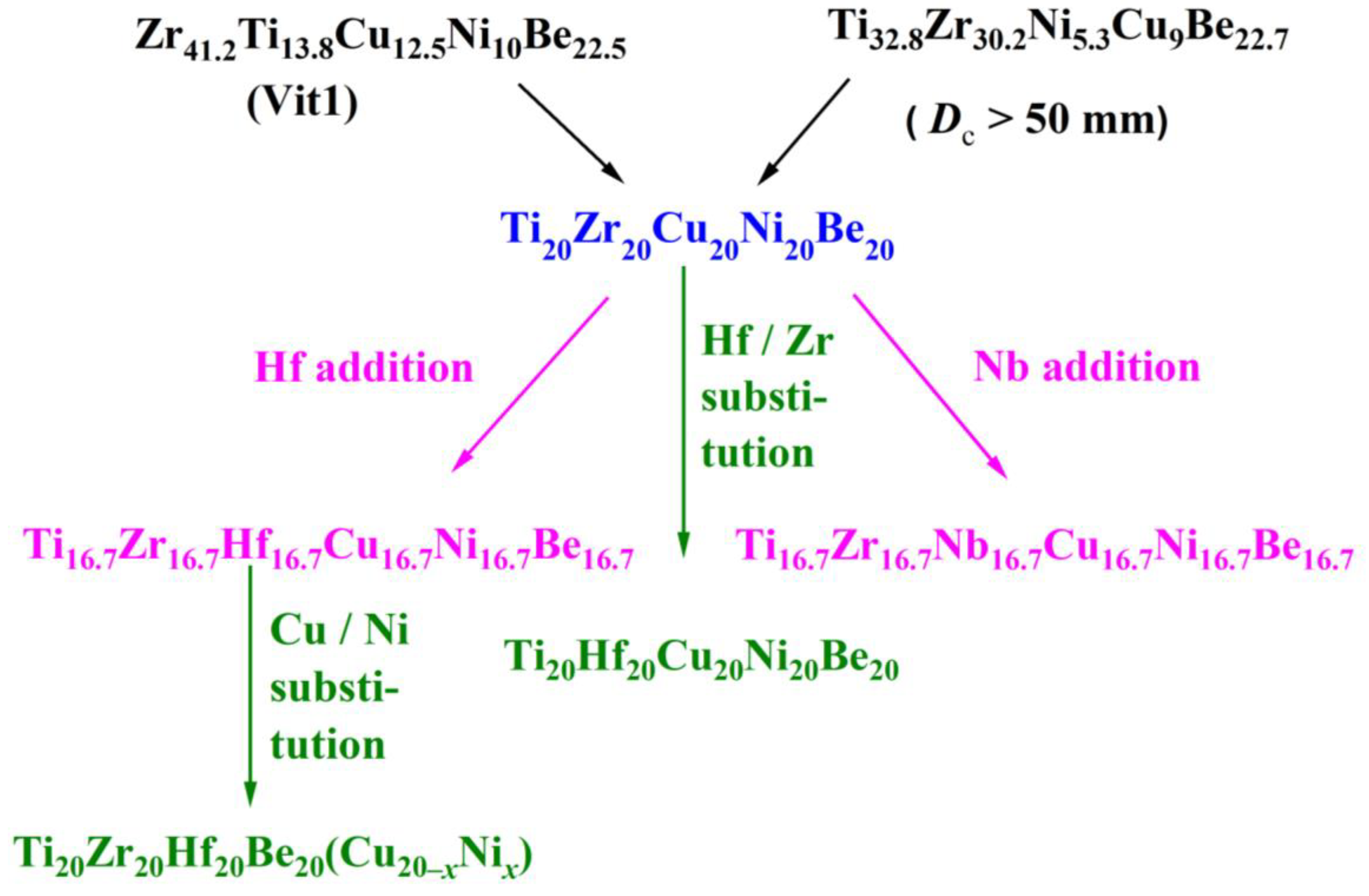
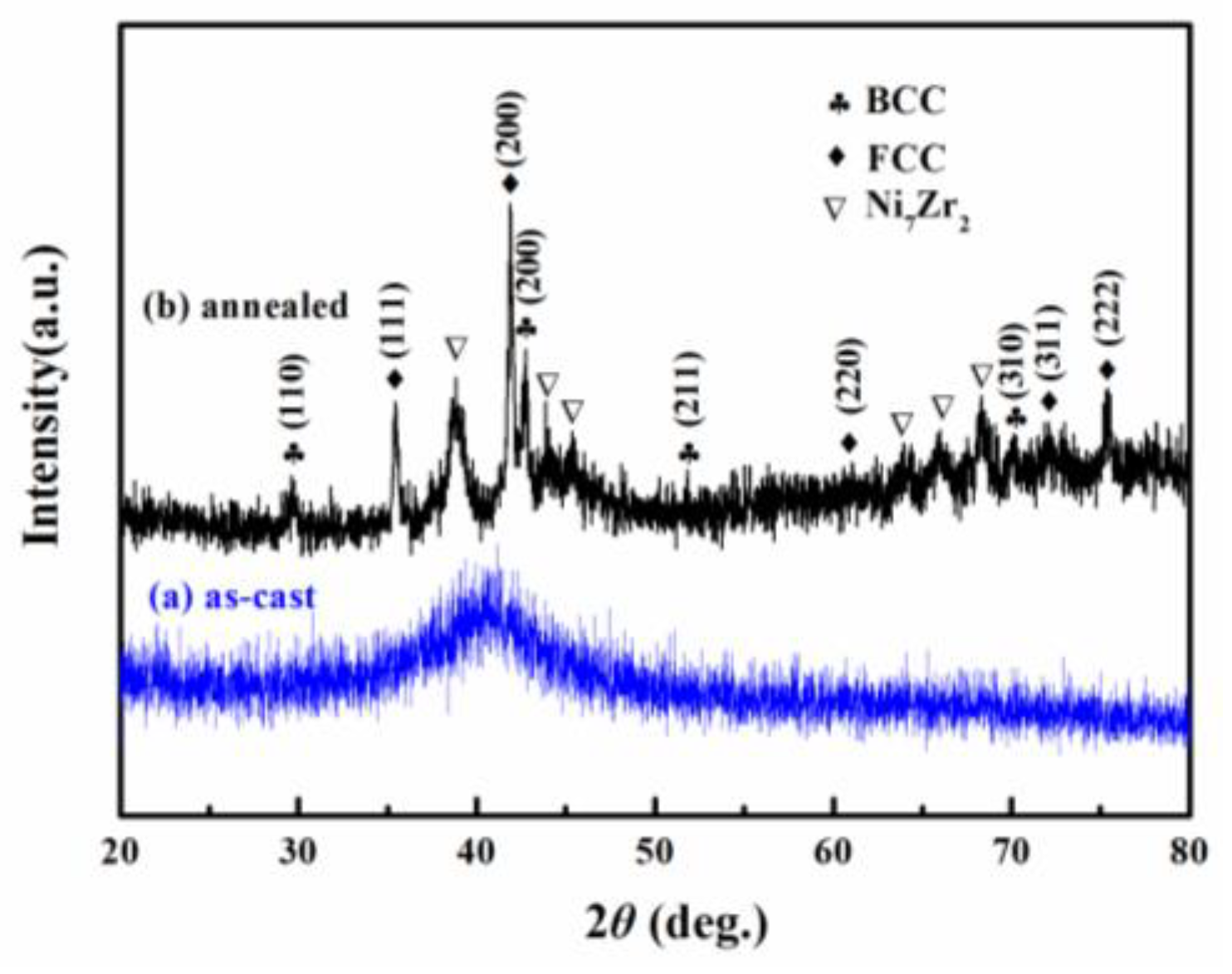
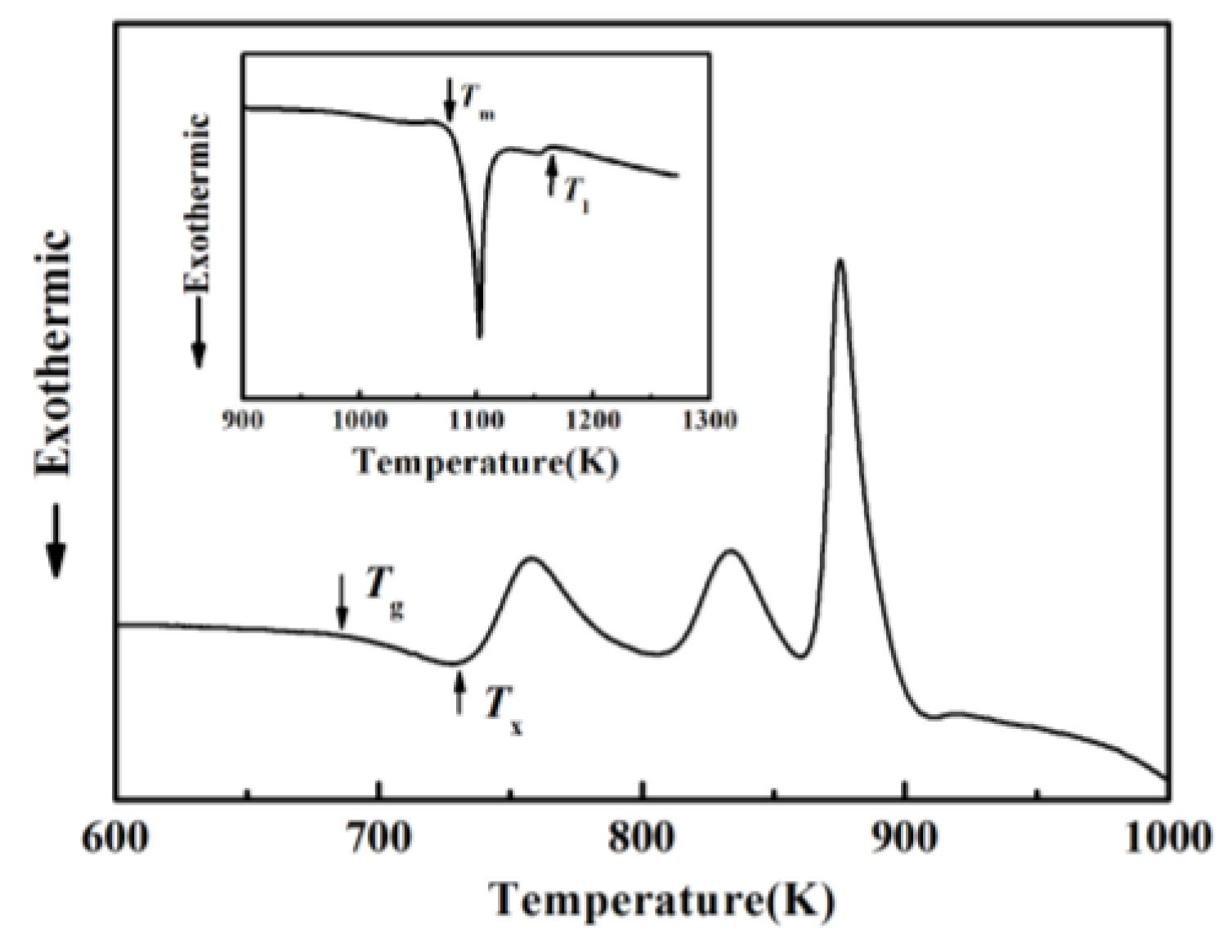
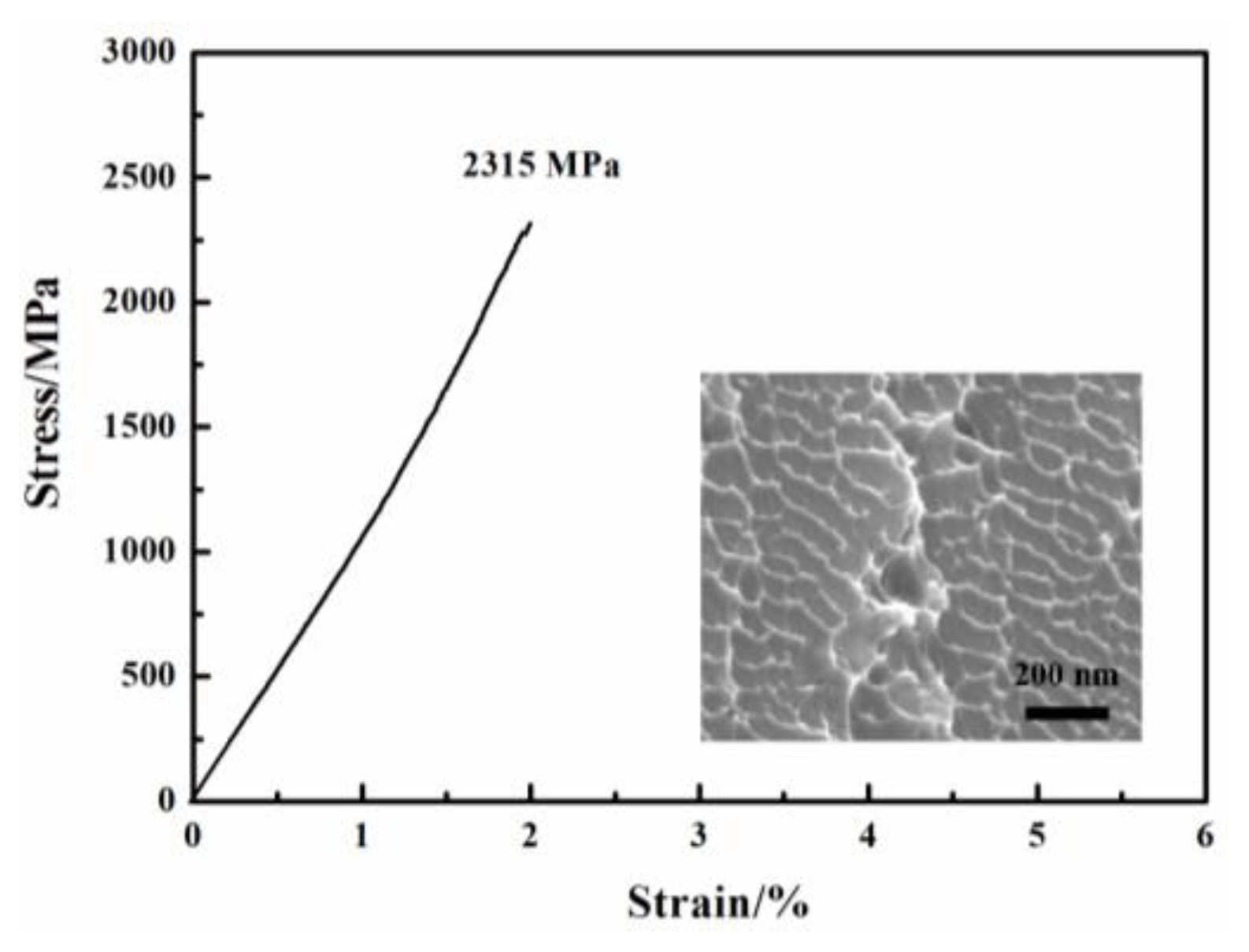
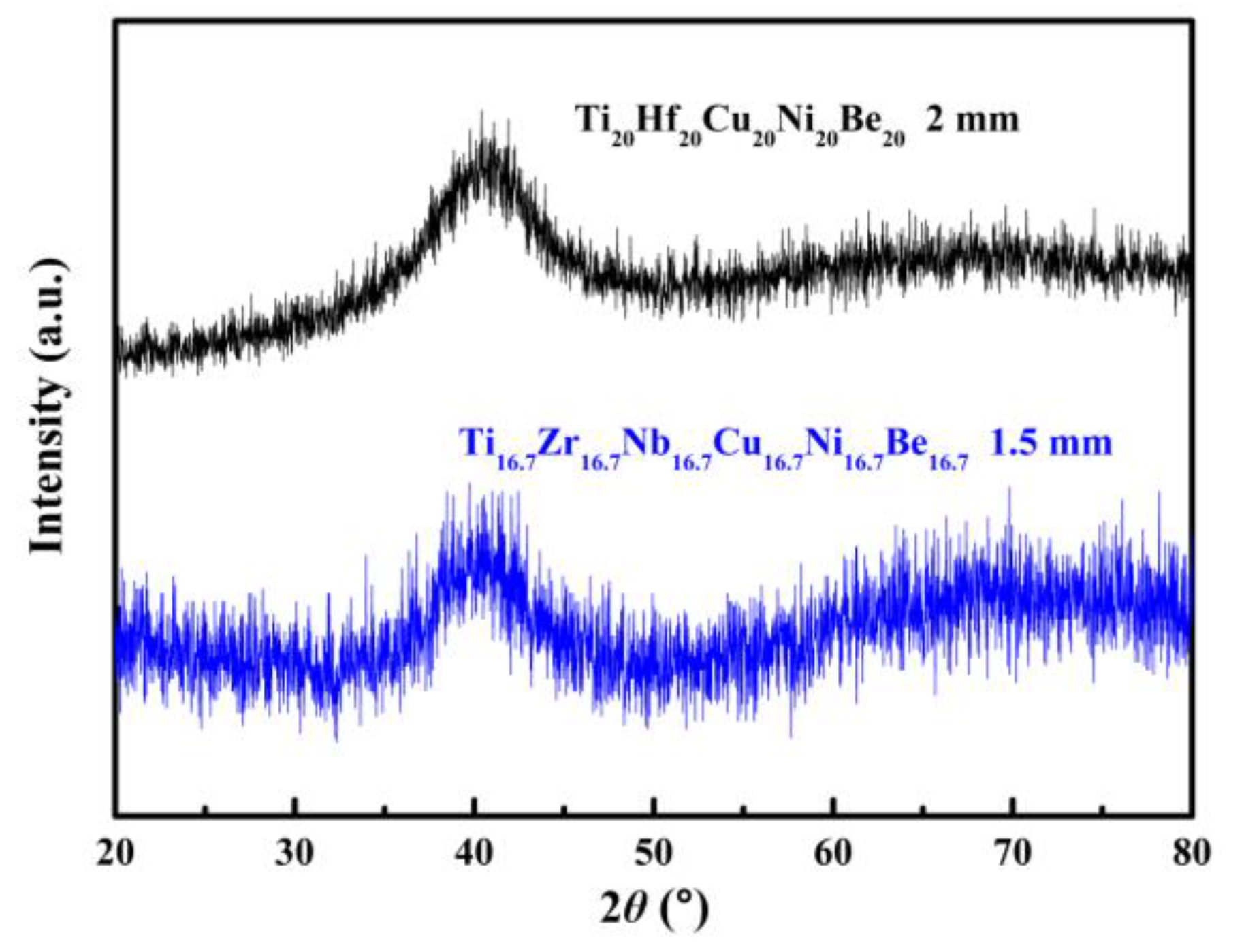

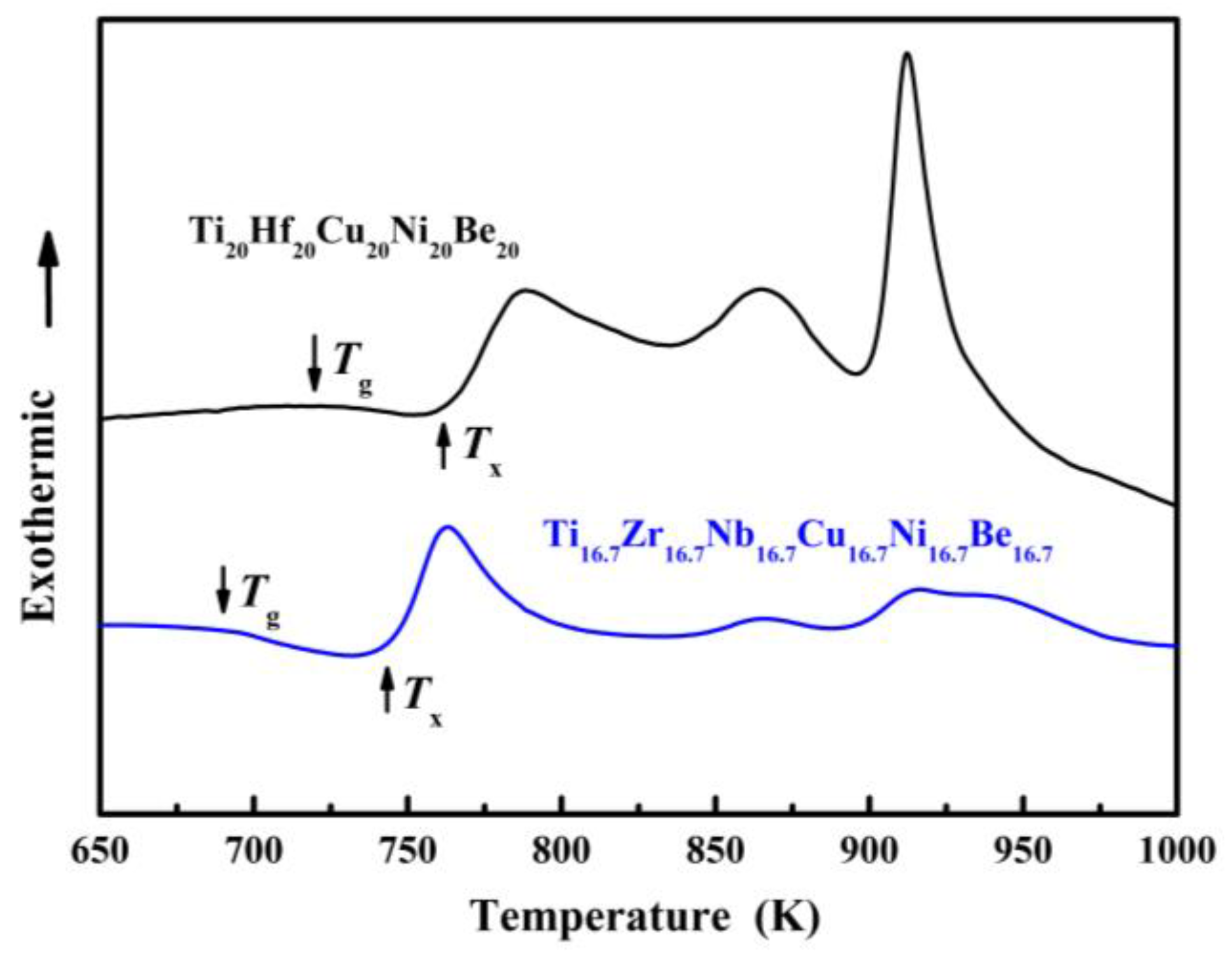

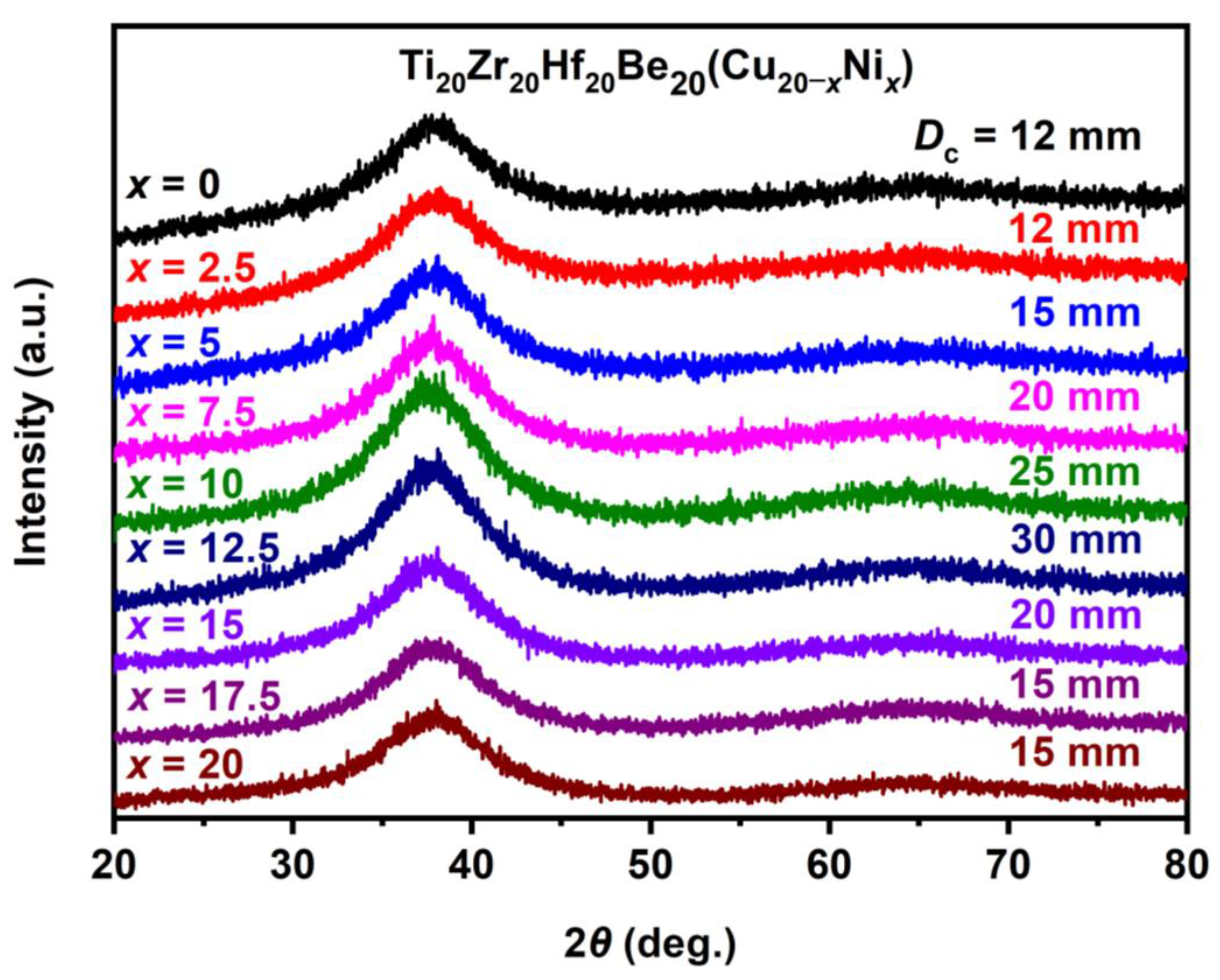
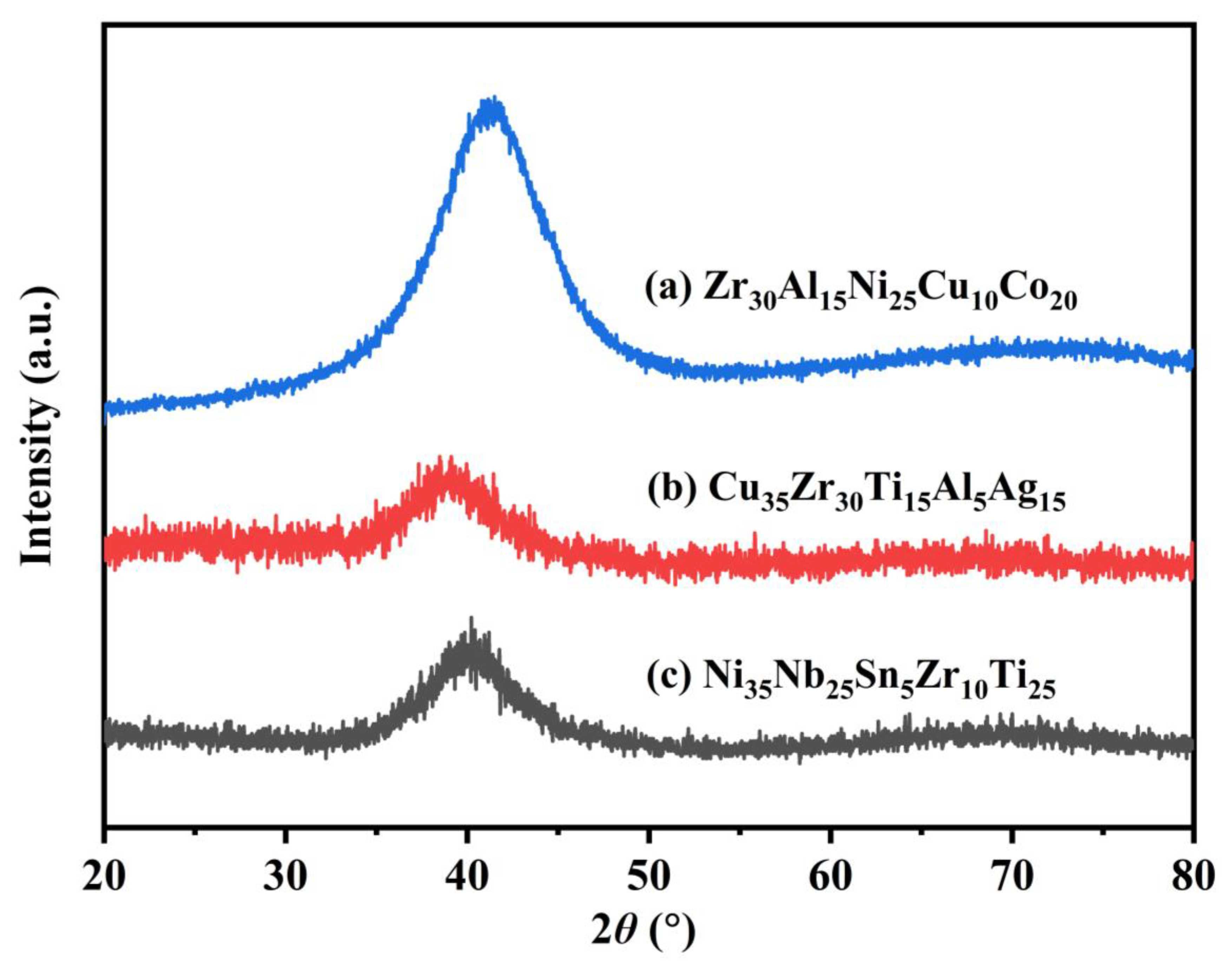
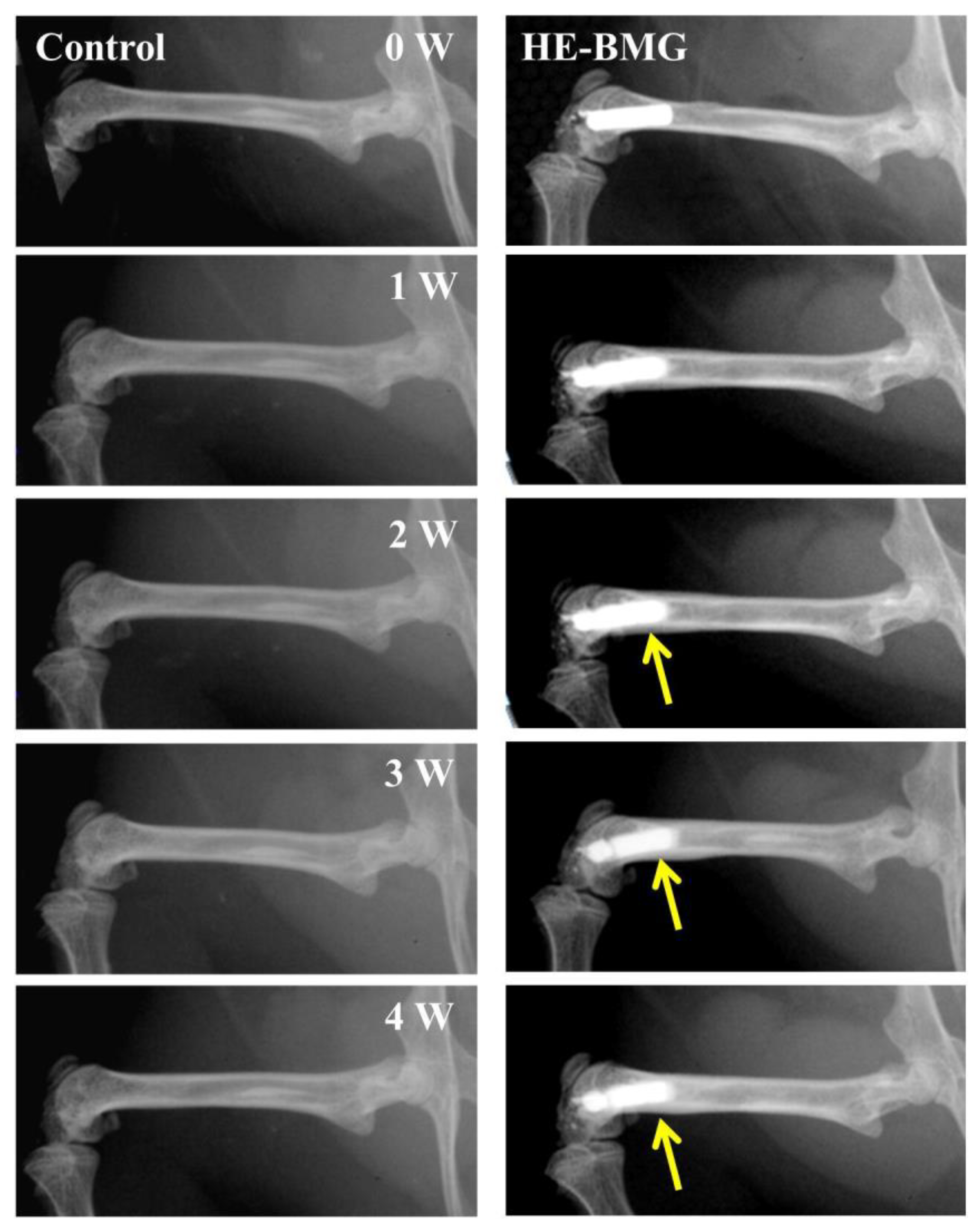
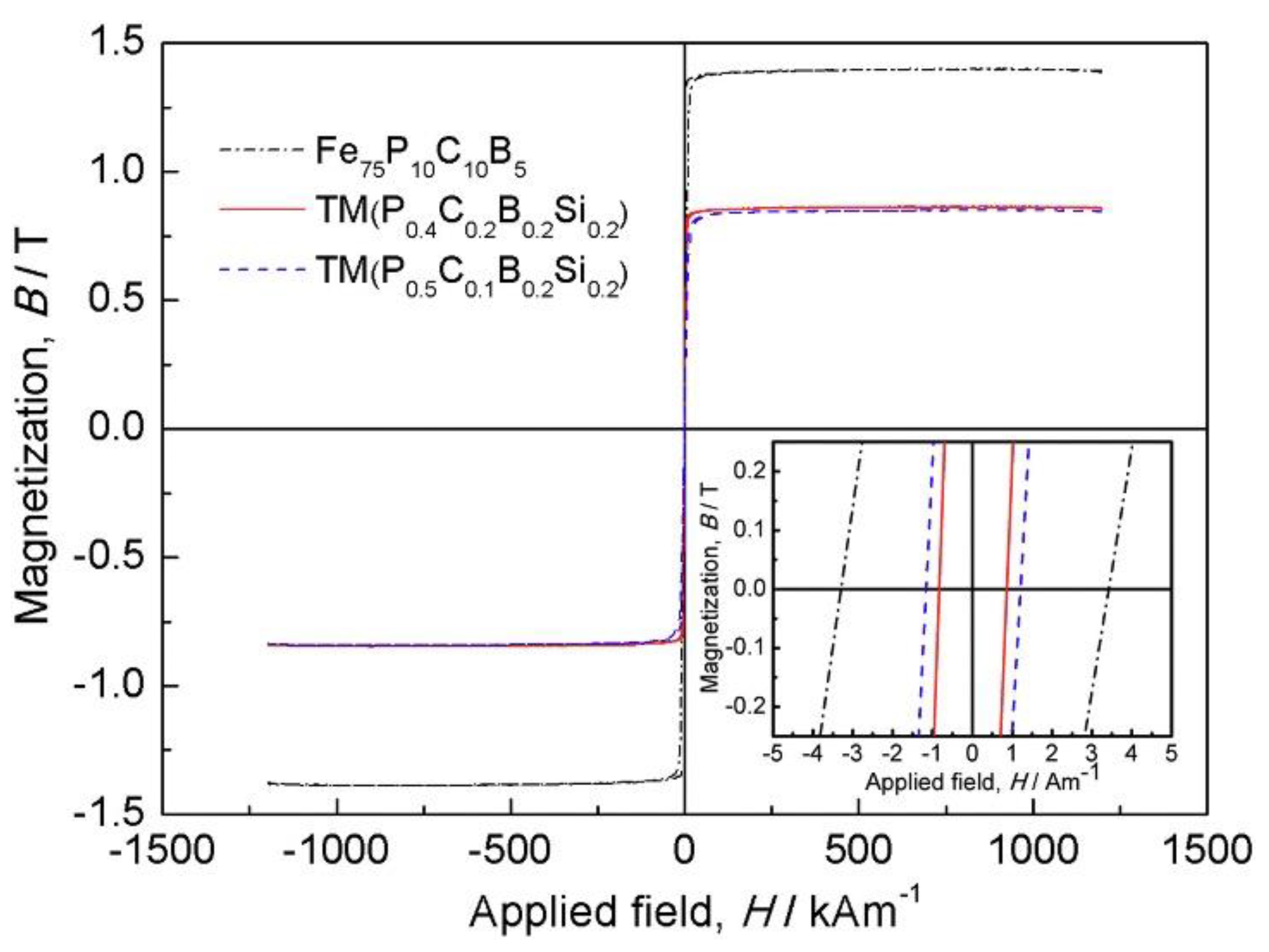


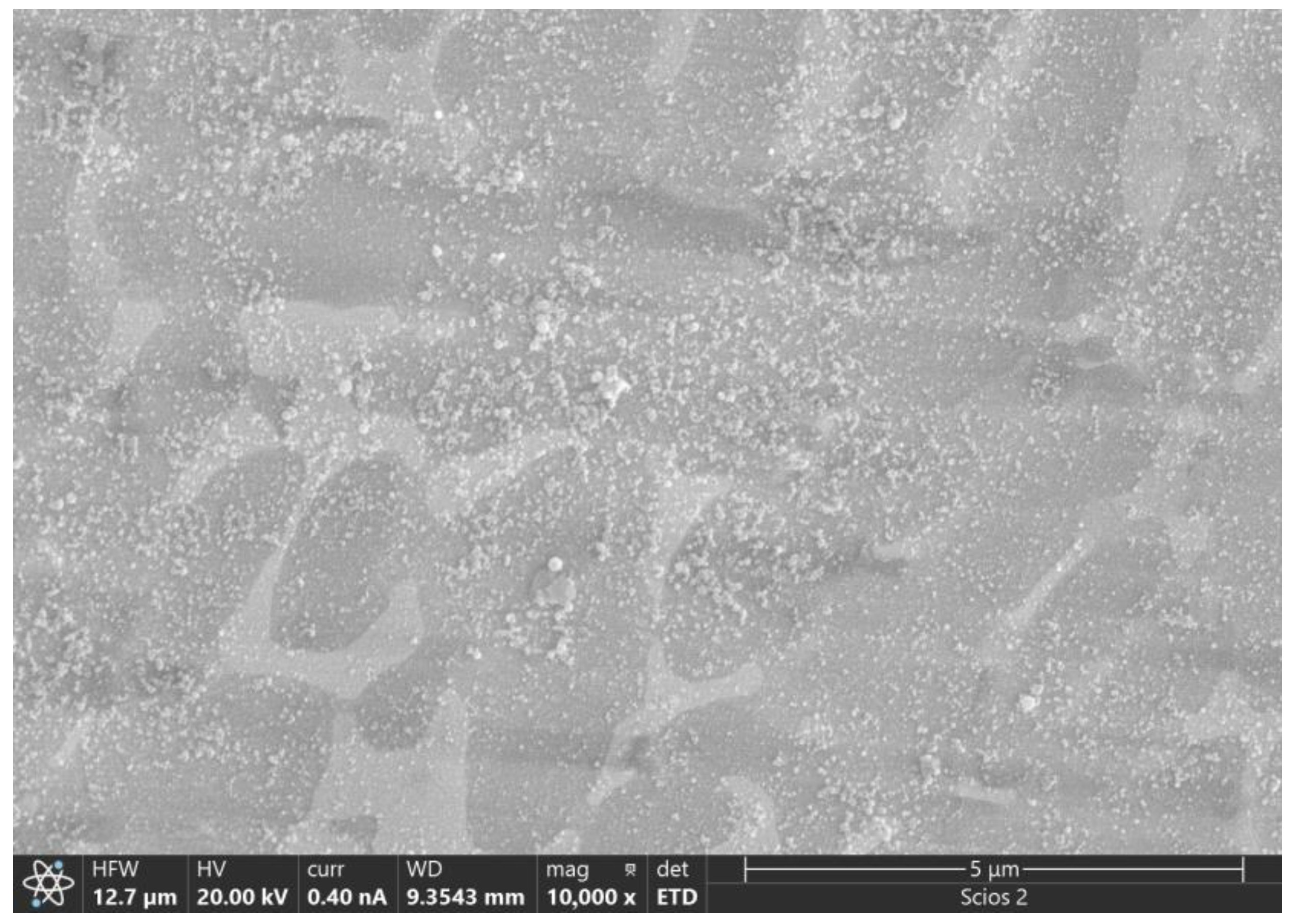
| Alloy No. | Composition | Tg (K) | Tx (K) | Tm (K) | Tl (K) | σmax (MPa) | Dc (mm) | ΔSmix (J/(mol·K)) | Year |
|---|---|---|---|---|---|---|---|---|---|
| 1 | Zr41.2Ti13.8Cu12.5Ni10Be22.5 (Vit1) | 625 | 705 | 937 | 993 | (<2000) | >50 | 12.17 | 1993 [4] |
| 2 | Ti32.8Zr30.2Ni5.3Cu9Be22.7 | 611 | 655 | - | 961 | 1831 | >50 | 11.94 | 2010 [15] |
| 3 | Ti20Zr20Cu20Ni20Be20 | 683 | 729 | 1076 | 1161 | 2315 | 3 | 13.38 | 2013 [35] |
| 4 | Ti16.7Zr16.7Hf16.7Cu16.7Ni16.7Be16.7 | 681 | 751 | 1019 | 1100 | 2064 | 15 | 14.90 | 2014 [36] |
| 5 | Ti20Zr20Hf20Cu7.5Ni12.5Be20 | 632 | 684 | 951 | 1040 | 2124 | 30 | 14.53 | 2015 [38] |
Disclaimer/Publisher’s Note: The statements, opinions and data contained in all publications are solely those of the individual author(s) and contributor(s) and not of MDPI and/or the editor(s). MDPI and/or the editor(s) disclaim responsibility for any injury to people or property resulting from any ideas, methods, instructions or products referred to in the content. |
© 2024 by the authors. Licensee MDPI, Basel, Switzerland. This article is an open access article distributed under the terms and conditions of the Creative Commons Attribution (CC BY) license (https://creativecommons.org/licenses/by/4.0/).
Share and Cite
Ding, H.; Zhang, Q.; Yao, K. Composition Design Strategy for High Entropy Amorphous Alloys. Materials 2024, 17, 453. https://doi.org/10.3390/ma17020453
Ding H, Zhang Q, Yao K. Composition Design Strategy for High Entropy Amorphous Alloys. Materials. 2024; 17(2):453. https://doi.org/10.3390/ma17020453
Chicago/Turabian StyleDing, Hongyu, Qi Zhang, and Kefu Yao. 2024. "Composition Design Strategy for High Entropy Amorphous Alloys" Materials 17, no. 2: 453. https://doi.org/10.3390/ma17020453
APA StyleDing, H., Zhang, Q., & Yao, K. (2024). Composition Design Strategy for High Entropy Amorphous Alloys. Materials, 17(2), 453. https://doi.org/10.3390/ma17020453




